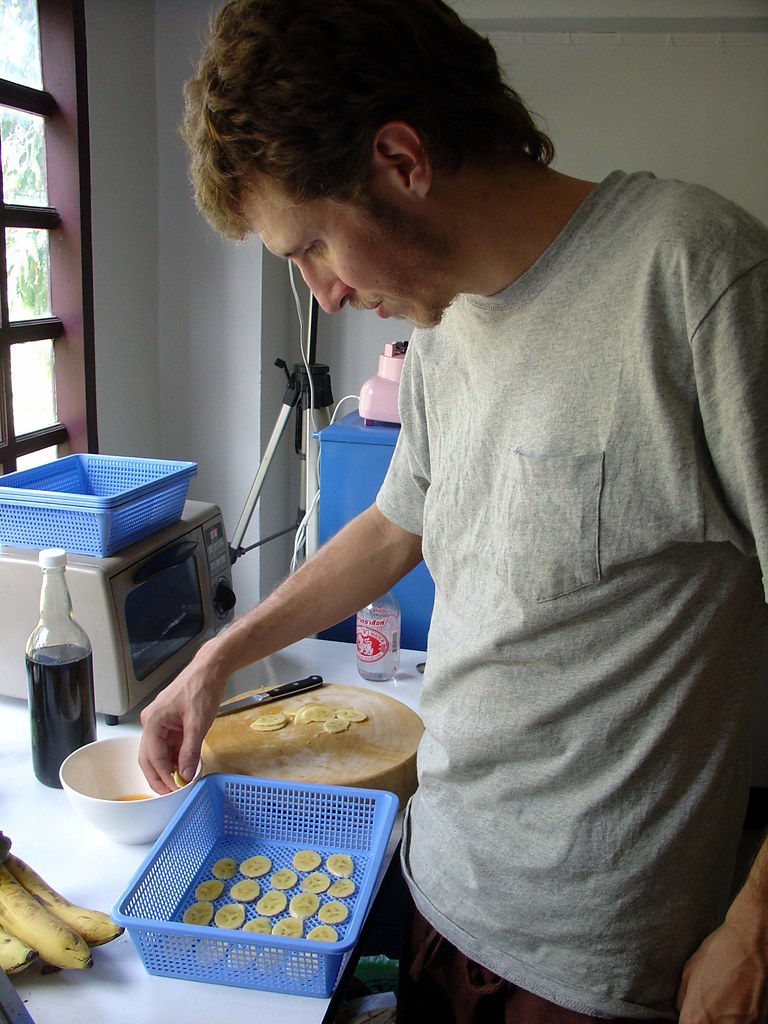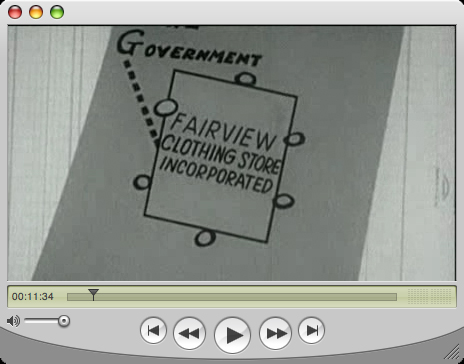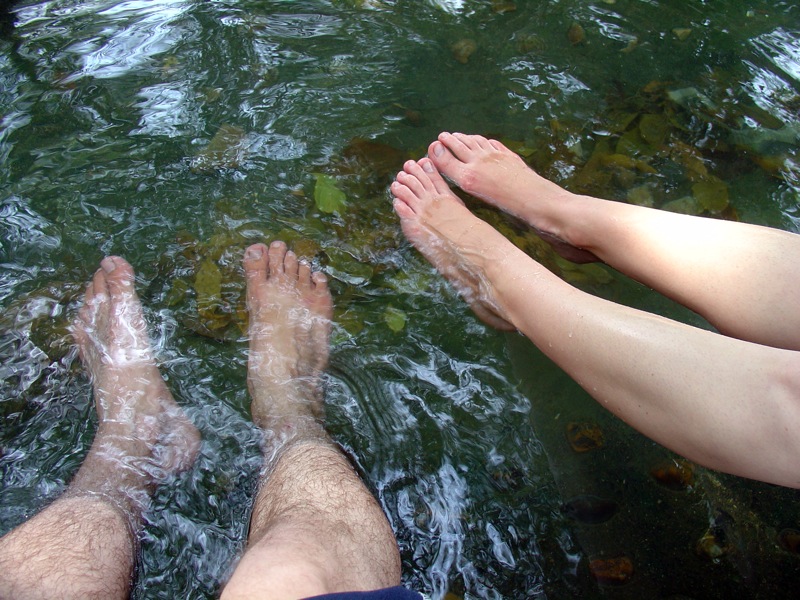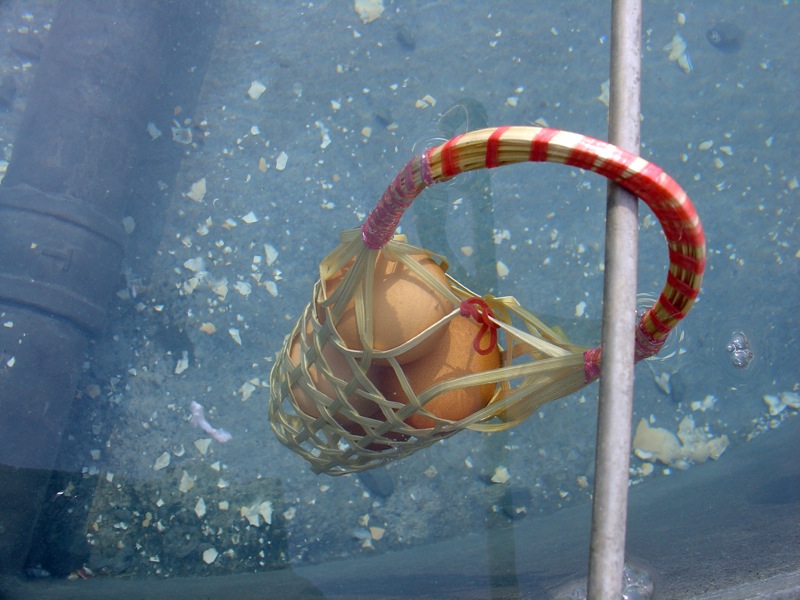J and I are pretty big fans of
Lost--though recently we have been bothered by the steady disappearance of minorities from the cast; new characters like "
Bobble-head," "
Haircut," and "
Boobies" annoy us to death; and we have mixed feelings in general about what I have dubbed "the
Fantasy Island Season." We're not such big fans that we wasted last summer on the
Lost Experience AR game, but big enough that we will read books that inspired the show, if they happen to be free. Well, an abused and coverless 99¢ Bantam paperback of
Aldous Huxley's Island happened to be living in this house when we got here. Years ago I was absolutely enthralled by
Brave New World (hey, I was fourteen), Huxley's distopian 1932 novel. While I'm sure
Brave New World isn't half as good as Dane@14 might have imagined,
Island was positively tedious, a 295 page sermon topped with an acid-trip (mushrooms, actually). Maybe I just prefer distopias to
utopias, as I found
B.F. Skinner's Walden Two equally tiring, and I read it shortly after
Brave New World. I seem to remember thinking the title was misleading. Being a huge fan of the real
Walden I must have imagined the book would have practical advice on growing beans, building a cabin, and finding your own pond beside which to build said cabin. It's also severely lacking in aesthetic bliss, something
Walden, has in abundance (though not without it's share of tedium, according to some--skip the
first chapter, I like it, but it tends to scare people off). I'd say that most utopian literature, in it's effort to remake the world, falls into the trap of didactic writing, or the "literature of ideas." Distopias, however, free from the restraints and conventions of some rigid notion of perfection, allow their writers to wander freely in search of whatever forms might be most appropriate, most novel, and most beautiful.

In his 1956 essay "On a Book Entitled
Lolita"
Nabokov wrote the following:
There are gentle souls who would pronounce Lolita
meaningless because it does not teach them anything. I am neither a reader nor a writer of didactic fiction, and, despite John Ray’s assertion, Lolita
has no moral in tow. For me a work of fiction exists only insofar as it affords me what I shall bluntly call aesthetic bliss, that is a sense of being somehow, somewhere, connected with other states of being where art (curiosity, tenderness, kindness, ecstasy) is the norm. There are not many such books. All the rest is either topical trash or what some call the Literature of Ideas, which very often is topical trash coming in huge blocks of plaster that are carefully transmitted from age to age until somebody comes along with a hammer and takes a good crack at Balzac, at Gorki, at Mann.Nabokov wrote his share of
distopian fiction, from Cincinnatus C.'s private torments in
Invitation to a Beheading (he was convicted of the bewilderingly obtuse, yet aesthetically precise crime of "gnostic turpitude"), to the circular machinations of "Ekwilist" totalitarianism in
Bend Sinister. Even
Pale Fire, in my opinion his best novel (though
Invitation to a Beheading is the one I'd take home with me), while not explicitly distopian, grows from the rich soil of
Invitation to a Beheading and
Bend Sinister. Somehow the freedom Nabokov sought as a writer was to be found in the bad place, rather than no-place.

Years ago I imagined I had a bone to pick with Ayn Rand, America's other Russian writer (interestingly, it seems she was friends with Nabokov's
younger sisters). I read
The Fountainhead and
The Romantic Manifesto shortly after my mission for the LDS church, and her philosophy of selfishness was not something I could merely shrug off, or interpret with anything but strict literalism. This was a few years before the word "blog" had even been coined, so my grand scheme was to write a scathing review on
Amazon.com. Though I never actually posted it, I did write a review of sorts, fragments of which survive in my sketchbooks from the time. I accused her being an intellectual bully (i.e. if you're not with her you're pinko), of being paranoid, and I made what I imagined were subtle implications, stating that the one piece of
real sculpture most like the fictional sculpture of
Dominique was created by a fascist (not to mention her penchant for
übermenschen). In some ways I've mellowed in the intervening nine years, enough that I thought I might give her another chance.
Altas Shrugged happens to be living here, too, at the moment, and I tried reading it, but the indelibly violet hues of Rand's prose drove me away. Which brings me back to the quote by Nabokov.
Nabokov's prose is, by all means, florid. Yet, in it's adamant refusal to "teach" us anything, it is somehow more honest, and in the end actually teaches us more. Rand's prose, on the other hand, is like the sugar coating on an Advil. It helps it go down, but don't you dare suck on it. I suppose thats the difference, one is a real meal, while the other is medicine (and mis prescribed at that). By way of comparison, here are a few paragraphs from each writer, one of Rand's passages from the first chapter of
Atlas Shrugged, and the first few paragraphs of Nabokov's
Speak Memory:
The great oak tree had stood on a hill over the Hudson, in a lonely spot on the Taggart estate. Eddie Willers, aged seven, liked to come and look at the tree. It had stood there hundreds of years, and he thought it would always stand there. It's roots clutched the hill like a fist with fingers sunk into the soil, and he thought that if a giant were to seize it by the top, he would not be able to uproot it, but would swing the hill, and the whole of the earth with it, like a ball at the end of a string. He felt safe in the oak tree's presence; it was a thing that nothing could change or threaten; it was his greatest symbol of strength.
One night, lightning struck the tree. Eddie saw it the next morning. It lay broken in half, and he looked into its trunk as into the mouth of a black tunnel. The trunk was only an empty shell; its heart had rotted away years ago; there was nothing inside--just a thin gray dust that was being dispersed by the whim of the faintest wind. The living power had gone, and the shape it left had not been able to stand without it.
Years later, he heard it said that children should be protected from shock, from their first knowledge of death, pain or fear. But these had never scared him; his shock came when he stood very quietly, looking into the black hole of the trunk. it was an immense betrayal--the more terrible because he could not grasp what it was that had been betrayed. It was not himself, he knew, nor his trust; it was something else. He stood there for a while, making no sound, then he walked back to the house. He never spoke about it to anyone, then or since.
______________________________________________________________
The candle rocks above an abyss, and common sense tells us that our existence is but a brief crack of light between two eternities of darkness. Although the two are identical twins, man, as a rule, views the prenatal abyss with more calm than the one he is heading for (at some forty-five hundred heartbeats an hour). I know, however, of a young chronophobiac who experienced something like panic when looking for the first time at homemade movies that had been taken a few weeks before his birth. He saw a world that was practically unchanged--the same house, the same people--and then realized that he did not exist there at all and that nobody mourned his absence. He caught a glimpse of his mother waving from an upstairs window, and that unfamiliar gesture disturbed him, as if it were some mysterious farewell. But what particularly frightened him was the sight of a brand-new baby carriage standing there on the porch, with the smug, encroaching air of a coffin; even that was empty, as if, in the reverse course of events, his very bones had disintegrated.
Such fancies are not foreign to young lives. Or, to put it otherwise, first and last things tend to have an adolescent note--unless possibly, they are directed by some venerable and rigid religion. Nature expects a full-grown man to accept the two voids, fore and aft, as stolidly as he accepts the extraordinary visions in between. Imagination, the supreme delight of the immortal and the immature, should be limited. In order to enjoy life, we should not enjoy it too much.
I rebel against this state of affairs. I feel the urge to take my rebellion outside and picket nature. Over and over again, my mind has made colossal efforts to distinguish the faintest of personal glimmers in the impersonal darkness on both sides of my life. That this darkness is caused merely by the walls of time separating me and my bruised fists from the free world of timelessness is a belief I gladly share with the most gaudily painted savage. I have journeyed back in thought--with thought hopelessly tapering off as I went--to remote regions where I groped for some secret outlet only to discover that the prison of time is spherical and without exits. Short of suicide, I have tried everything. I have doffed my identity in order to pass for a conventional spook and steal into realms that existed before I was conceived. I have mentally endured the degrading company of Victorian lady novelists and retired colonels who remembered having, in former lives, been slave messengers on a Roman road or sages under the willows of Lhasa. I have ransacked my oldest dreams for keys and clues--and let me say at once that I reject completely the vulgar, shabby, fundamentally medieval world of Freud, with its crankish quest for sexual symbols (something like searching for baconian acrostics in Shakespeare's works) and its bitter little embryos spying, from their natural nooks, upon the love life of their parents.
Both of these passages deal with time, intuitions regarding eternity, mortality, a desire to rebel against nature, or a corresponding sense of betrayal. Nabokov, in his disdain for Freud, manages to shed some new light on the realm of
Thanatos and the mirror terrors of darkness (or the unknown, depending on you religious persuasion) framing mortal life. Rand, on the other hand, in language fit for an adolescent serial, presents us with a modernist allegory of human strength contrasted with the decay of nature. It is perhaps her genius, as a female writer, to endow her character with a stereotyped case of
castration anxiety. In fact, she seems obsessed by phallic symbols of power, "great oak tree[s]," trains, skyscrapers, the generative powers of masculine industry (a simple perusal of the comments on almost any popular blog will readily expose one to the hyper-masculine
folly of the randian superman). In someways she is a proto-
Performatist, too poorly situated historically to have absorbed the postmodern virtues of tolerance and play. Nabokov, however, presents us with a subject that is more permeable. His world is one of continuous
glissement, an eternal renegotiation of terms, an infinite game. Even Cincinnatus C., who's essence we may imagine to be more real than that of those around him (much like a randian hero), is permeated by his love for his inscrutable (and perhaps impenetrable) wife, his fraught friendship with his executioner, his nascent infatuation with his jailer's daughter. Cincinnatus's crime, as mentioned above, is "gnostic turpitude," a bafflingly vague term for which I offer two interpretations. Turpitude, of course, means wickedness or depravity, while gnostic, in its use here as an adjective, could refer to either one's essential nature, the sparks of being which emanated from deity, or, more conventionally, to a secret knowledge which sets one apart from the rest of humanity. Both readings of his crime could serve to identify him with Rand's heros, the creative geniuses of commerce and industry, isolated and derided despite their integrity and discernment. Cincinnatus has no peers, Roark likewise has few if any (his relationship with Dominique is hardly evenly yoked, she must first be taught, re-formed in his image). However, Nabokov does not set out to teach us anything, does not hold up his characters as exemplars of a moral life, while Rand does, and emphatically so.
As much as I enjoy deriding Rand and championing Nabokov, I still have to ask myself if there might be something wrong with his, and therefore my, assumptions about didactic art and aesthetic bliss. This past summer I was fortunate enough to attend a talk given by
Jeanne-Claude and Christo as part of their show at the Austin Museum of Art (perhaps one of the most miserable little museums in Texas). At the beginning of the Q&A portion of the talk Jeanne-Claude, in her bad-cop role, stated very specifically that they would not answer questions about politics, religion, or anything of that nature. Their art, as they have stated in the past, is not intended to be political in any way, but instead is designed to bring greater aesthetic bliss into the world. I appreciate their position, and feel it is certainly appropriate for someone who escaped communist Hungary by hiding in a truck (Christo), nearly starved to death during WWII (Jeanne-Claude), or who's
father was wrongly killed in a bungled assassination attempt on another man (Nabokov). However, I cannot escape my gut reaction that their desire to be strictly apolitical in this day and age is somehow quaint. Vladimir and Vera Nabokov were terrified of student protests during their stay in the United States. Understandable since both had experienced firsthand the rise of Communism in Russia, and Fascism in Germany. Christo and Jeanne-Claude are a generation younger than the Nabokovs, and while entitled to their desire to separate Art and State, it may not be the ideal position for younger artists. Though, it should be made clear that having a political or social agenda does not automatically mean that one is a creator of didactic art, but one might be running perilously close to the edge.

Some years ago I had an argument with a friend, an agitator for "indie" art in her own community of home-schools and
founding-father style statesmanship, over the use of the propagandistic mode in art. It was her opinion that art should be used for the good of the nation, to promote values based on the classics and scripture. Having grown up confronting the notion that the role of art was to provide tacky illustrations for church magazines, the idea that art should somehow be put to some good work, however moral it might be, was repugnant. I held, and I still hold, that the true value of art is to provide an unencumbered space in which to work out one's difference, whatever that may be, and in whatever form it may take. Though my ideas about what constitutes an unencumbered space have certainly changed over the years, I do not think one's artistic practice should merely be an ideological outlet for a "quality" education. To return to Christo and Jeane-Claude, while their art as seen is essentially formal, and, as stated, is not intended to make any type of political or social statement, their practice embodies a number of values regarding fiscal, social, and environmental responsibility. They fund the projects themselves. They investigate the community where the work is to be installed and seek it's approval, often on a door to door basis. The fabrics and other materials they use are recycled, so that hopefully nothing ends up in a landfill. This type of artistic practice goes deeper than politics, and is based on a notion of personal responsibility that one wishes were universal. But the artworks themselves do not contain any such message, they are monumentally formal objects, designed to disarm us with their beauty, rather than teach from a position of moral authority.
People like B.F. Skinner, Aldous Huxley, and Ayn Rand are unable to break free of the ideological constrains they put on their art. They are propagandists for their own cause, giving the framework priority over its content, and letting beauty fall by the wayside. Thoreau, Nabokov, and Jeanne-Claude and Christo place beauty first, allowing their values to find expression naturally in the context of a complete and undamaged work of art. What exactly beauty is is not a subject I'm prepared to tackle at the moment. For now, I'll just have to play the philistine--I don't know much, but I know what I like, and I much prefer beauty to moralizing.
































